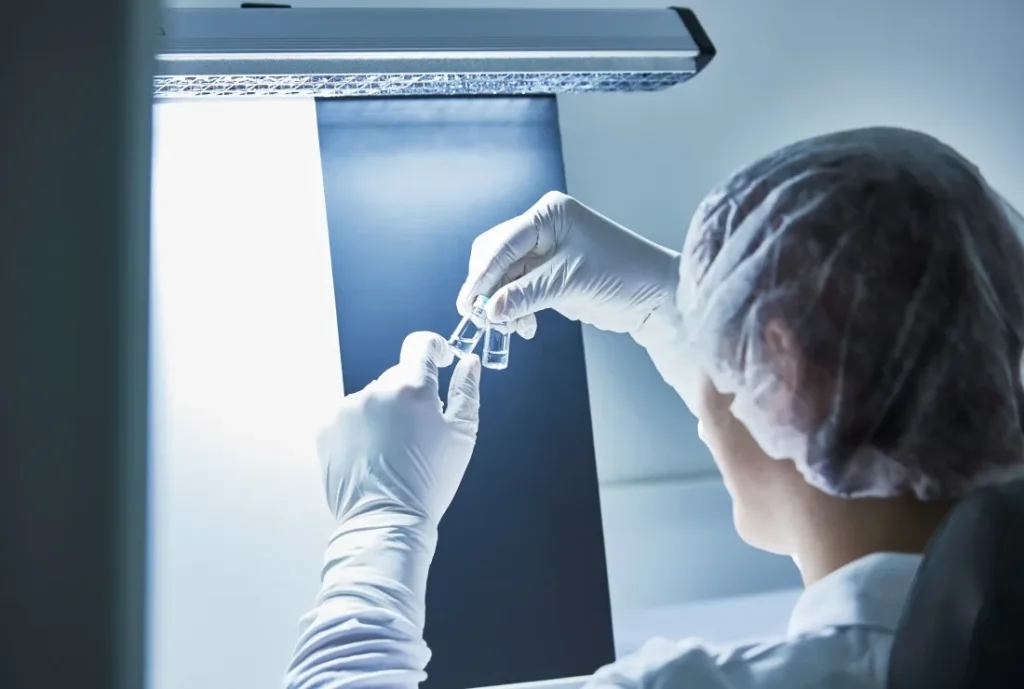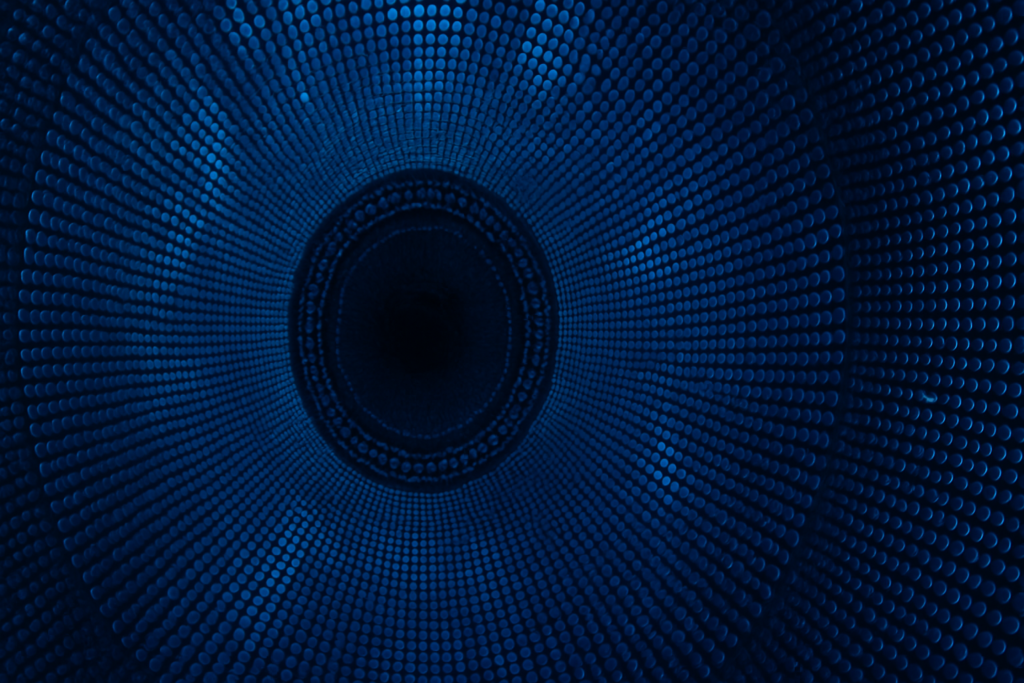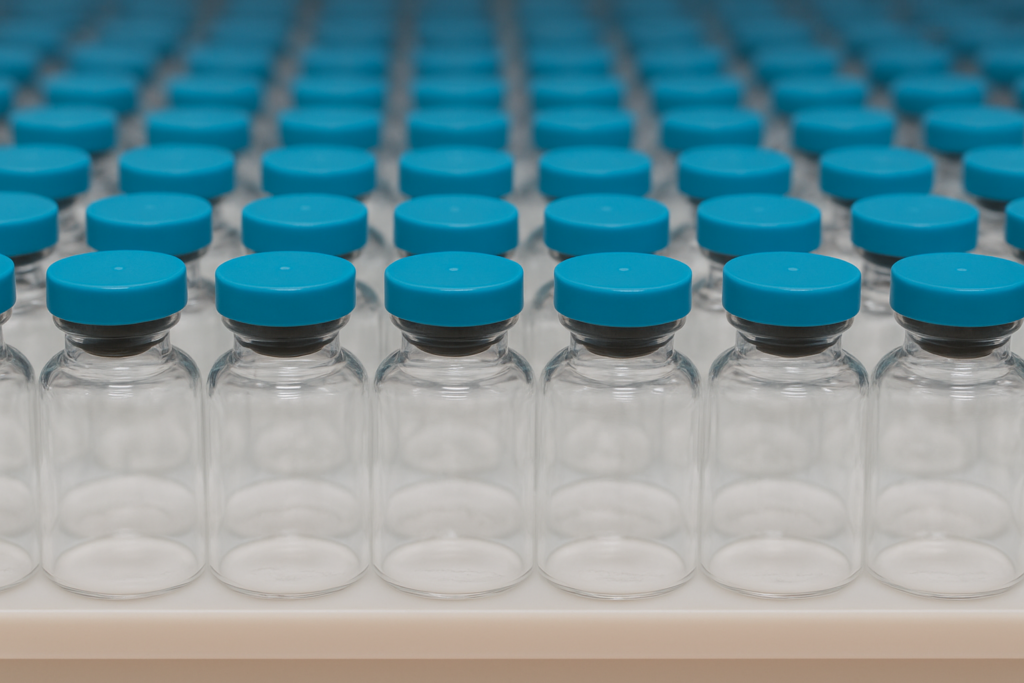Introduction
In pharmaceutical manufacturing, visual inspection remains a critical step to ensure patient safety. Every vial, syringe, or container must be thoroughly examined to detect contaminants, seal integrity issues, or other defects before reaching patients. Traditionally, this crucial task has relied heavily on human inspectors – trained professionals who manually inspect each unit against standardized criteria. However, as manufacturing volumes increase and product complexity grows, the limitations of human-based inspection become increasingly apparent.
The pharmaceutical industry faces a pivotal challenge: how to maintain the highest quality standards while addressing the inherent limitations of human inspection. This is where AI-based visual inspection systems are transforming quality control processes. By leveraging advanced algorithms and machine learning, these systems offer a promising solution to reduce error and enhance detection capabilities.
Challenges with Human Inspectors
Fatigue and Attention Limitations
Human inspectors, no matter how skilled, are susceptible to fatigue. Manual inspection requires intense concentration for extended periods, with inspectors often examining hundreds or thousands of units per shift. As noted by Vasadi Figueroa and Ferer in PDA Letter, human inspectors must remain laser-focused and not be easily distracted, as “even a momentary glance away from the inspection booth could permit defective products to go through the viewing area unseen” (1). This intense concentration requirement leads to fatigue, which is why USP <1790> (2) and industry practices recommend frequent breaks for inspectors in order to maintain detection performance.
Inconsistency Between Inspectors
Studies consistently show significant variability between different human inspectors examining the same set of products. As Shabushnig notes in an interview with Pharmaceutical Technology, “Human inspectors are flexible and can respond to something they have never seen before or something that ‘doesn’t look right,'” but this flexibility leads to greater variation in manual inspection results (3). This variation in detection capabilities between inspectors creates quality control challenges and raises concerns about potentially missed defects, which is precisely why a robust challenge with a set of good containers seeded with known defects is recommended as a best practice for training.
Limited Detection Probability
Human visual detection has inherent limitations, particularly for small, subtle, or complex defects. Visual inspection is probabilistic, with many defects never reaching 100% detection probability, and factors like size, shape, color, contrast, location, and inspector experience significantly influence whether a defect will be detected. In fact, for particulates smaller than 100 microns or defects in difficult-to-inspect areas like container shoulders or bases, human detection rates can fall below 70%.
Training and Qualification Challenges
Effective human inspection requires extensive training and specific personal attributes. Finding individuals with the right visual acuity, attention to detail, and ability to maintain focus presents a significant recruitment challenge. Additionally, maintaining consistent qualification standards across a workforce requires substantial resources and ongoing assessment.
Recalls and Missed Defects
Rising Recall Trends
The pharmaceutical industry has witnessed an upward trend in product recalls, particularly related to undetected particulate matter. In his Pharmaceutical Technology interview, Shabushnig explains that recalls have increased due to visual defects, especially for glass particles (3). This trend stems from growing concerns about the formation of glass fragments resulting from interactions between liquid products and delaminated glass container surfaces. These recalls create significant financial burden, damage company reputations, and attract regulatory scrutiny, causing manufacturers to take increasingly conservative approaches by recalling batches that would actually be acceptable if thoroughly inspected.
Clinical Impact
The presence of particulate matter in injectable products presents significant clinical risks. Hard particles like glass or metal can cause vascular occlusion, tissue injury, and inflammatory responses. While anecdotal evidence exists regarding patient harm from particulate contamination, the lack of comprehensive clinical studies has led regulatory bodies to adopt increasingly conservative positions on particle acceptance limits.
Regulatory Scrutiny
Regulatory expectations for visual inspection have intensified in recent years. The FDA and global regulatory bodies have issued multiple warning letters to numerous manufacturers related to inadequate visual inspection processes. Failed Acceptable Quality Limit inspections, as noted in recent case studies, can result in thousands of dollars in additional production costs and potentially jeopardize manufacturing approvals.
Advantages of AI-Based Inspection
Consistent Performance
Unlike human inspectors, AI systems maintain the same detection sensitivity throughout the production run, regardless of time of day, shift length, or production volume. This consistent performance eliminates the variability associated with human fatigue or attention fluctuations.
Higher Detection Rates
Advanced AI-based systems have demonstrated superior detection capabilities for many defect types. In controlled studies, systems like Boon Logic’s AVIS have achieved detection rates exceeding 98% across multiple defect categories, significantly outperforming human inspection for challenging defects like hairline cracks, small particulates, and subtle container integrity issues.
Reduced False Eject Rates
One of the most significant advantages of modern AI-based inspection systems is their ability to reduce false reject rates. Traditional automated visual inspection systems often produce false reject rates of 10–30%, while advanced AI systems like AVIS can achieve false reject rates as low as 3%. This translates directly to improved production yields and lower costs.
Rapid Recipe Development
Modern AI systems dramatically reduce the time required to develop inspection recipes. Traditional rule-based systems often require weeks or months of programming and parameter tuning. In contrast, AVIS creates complete inspection recipes in less than an hour using unsupervised machine learning, enabling faster product changeovers and validation.
Comprehensive Documentation
AI systems automatically generate detailed inspection records, including images of detected defects, anomaly scores, and decision criteria. This comprehensive documentation supports regulatory compliance and provides valuable data for continuous process improvement.
When to Use AI-Based Inspection
Difficult-to-Inspect Products
Products with high inherent variability present significant challenges for human inspectors and traditional automated systems. Lyophilized (freeze-dried) products, suspensions, powder-filled vials, molded glass containers, and colored solutions all introduce complexities that make consistent inspection difficult. AI-based systems excel with these challenging products by learning the normal range of acceptable variation.
High-Volume Production
For high-volume products, the economic benefits of AI-based inspection are particularly compelling. The consistent performance and reduced false reject rates directly translate to higher yields and lower costs. In high-volume scenarios, even small improvements in reject rates can generate substantial savings of up to $3.5 million for production volumes of 1–5 million units.
Why AVIS is the Best Solution: Learning Normal to Detect Abnormal
Unsupervised Machine Learning Advantage
Unlike supervised machine learning approaches that require extensive labeled defect libraries, AVIS employs unsupervised machine learning through Boon Logic’s proprietary Boon Nano algorithm. This approach enables the system to learn what “normal” looks like by analyzing only compliant units, rather than requiring examples of every possible defect type.
Rapid Recipe Creation
Boon Nano’s unsupervised learning approach dramatically accelerates inspection recipe development. AVIS requires only 500 pre-inspected compliant units to create a complete inspection recipe in less than an hour. This eliminates the need for extensive defect libraries and allows manufacturers to quickly implement inspection for new products or product variations.
Learning Normal Variation
By focusing on learning normal variation, AVIS develops a comprehensive understanding of acceptable product characteristics. The system learns all the subtle variations in compliant units, including powder distributions, bubble patterns, fill levels, and container features. This approach is particularly valuable for products with high inherent variability, such as lyophilized cakes or powder-filled vials.
Proven Performance
In real-world applications, AVIS has demonstrated exceptional detection capabilities while maintaining low false reject rates. For example, in a case study involving 20-ml powder-filled molded glass vials, AVIS achieved 98% defect detection accuracy with a false reject rate of only 2.7%, significantly outperforming human inspection for this challenging product.
Conclusion
The limitations of human visual inspection present significant challenges for pharmaceutical manufacturers seeking to ensure product quality and patient safety. AI-based inspection systems, particularly those leveraging unsupervised machine learning like Boon Logic’s AVIS, provide a compelling solution by addressing the consistency, detection capability, and efficiency constraints of manual inspection.
By learning from normal variation rather than focusing on defect libraries, these advanced systems can rapidly adapt to new products, reduce false reject rates, and detect subtle defects with high reliability. As manufacturing complexity increases and regulatory expectations intensify, AI-based inspection represents not just an alternative to human inspection but a necessary evolution in pharmaceutical quality control.
For products that are difficult to inspect or manufactured in high-mix and medium-to-low volumes, AI-based inspection offers a path to enhanced quality, improved efficiency, and ultimately, better patient safety.
Resources
- Vasadi Figueroa, V., & Ferer, R. (2023). Reducing Human Error for Manual Visual Inspection. PDA Letter. Published October 26, 2023.
- U.S. Pharmacopeia (2023). USP <1790> Visual Inspection of Injections. United States Pharmacopeial Convention.
- Shabushnig, J. (2021). Visual Inspection: Seeing Room for Improvement? Interview with Pharmaceutical Technology, Vol.45 (11): 60–63.
- Boon Logic (2024). How AI-based Visual Inspection Reduces False Eject Challenges. Blog post.
- U.S. Food & Drug Administration (2021). Inspection of Injectable Products for Visible Particulates. Draft Guidance for Industry. December 2021.
- Marsale, T. (2023). Balancing Act: Human vs. Machine Inspection in Pharmaceutical Manufacturing. PDA Letter. Published October 18, 2023.
- Turnquist, B. (2024). Case Study: Replacing Human Inspection of Powder-Filled Molded Glass with AI-based Inspection. Boon Logic.
- Melchore, J. (2011). Sound Practices for Consistent Human Visual Inspection. AAPS PharmSciTech, 12(1), 215-221.



